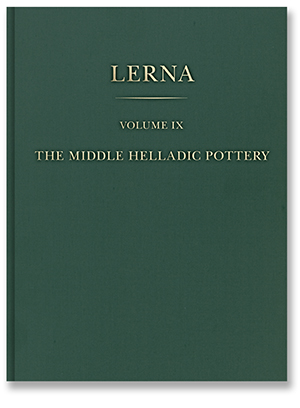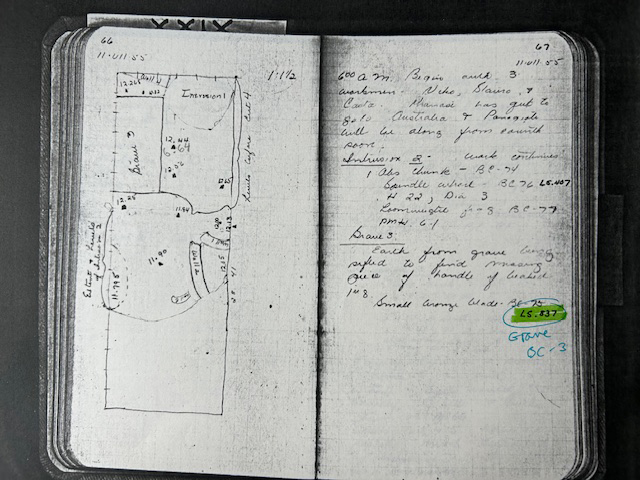
A Work for the (Middle Bronze) Ages
 In the ASCSA’s latest publication, Lindsay C. Spencer presents the Middle Helladic (MH) pottery from Lerna, an important prehistoric site on the shore of the Gulf of Argos. Excavations led by John Caskey in the 1950s revealed well-preserved stratigraphy recording 5,000 years of occupation, from the 6th to the 1st millennium BCE. Although Lerna’s status as a key “typesite” and master sequence for the Early and Middle Bronze Ages on the southern Greek mainland was recognized early on, the site’s MH material remained largely unpublished until now. Spencer’s monumental new volume presents a catalogue of the MH ceramic material—over 2,400 objects—along with an analysis of shapes, decoration, and fabrics, elucidating the changing patterns of ceramic production and consumption at Lerna in this poorly understood period of prehistory. Now at work on a companion volume on Lerna’s MH architecture and stratigraphy, Spencer recently took time to discuss the history of the project that became the Lerna IX volume and her work on the MH period more broadly.
In the ASCSA’s latest publication, Lindsay C. Spencer presents the Middle Helladic (MH) pottery from Lerna, an important prehistoric site on the shore of the Gulf of Argos. Excavations led by John Caskey in the 1950s revealed well-preserved stratigraphy recording 5,000 years of occupation, from the 6th to the 1st millennium BCE. Although Lerna’s status as a key “typesite” and master sequence for the Early and Middle Bronze Ages on the southern Greek mainland was recognized early on, the site’s MH material remained largely unpublished until now. Spencer’s monumental new volume presents a catalogue of the MH ceramic material—over 2,400 objects—along with an analysis of shapes, decoration, and fabrics, elucidating the changing patterns of ceramic production and consumption at Lerna in this poorly understood period of prehistory. Now at work on a companion volume on Lerna’s MH architecture and stratigraphy, Spencer recently took time to discuss the history of the project that became the Lerna IX volume and her work on the MH period more broadly.

Archival photo of the site of Lerna, from the west
Spencer’s first encounter with Lerna material came during her Ph.D. research, which focused on pottery technology and socioeconomic diversity on the Greek mainland during the Early and Middle Helladic periods. She recalls spending a “very happy week in the Argos Museum trying to get to grips with what the EH III period looked like in the Argolid.” She had already developed a fascination with the MH period while working on her M.A. thesis, intrigued by how little was understood about the years preceding the emergence of the Mycenaean palaces. Once notoriously described as “the third world” of the Aegean Bronze Age, the MH period seemed like an underdog of sorts, and Spencer couldn’t help but root for it. She wanted to understand it better, even if other scholars had deemed it uninteresting, and not least because she was finding that “a lot of observations about MH ceramics didn’t seem to fit in with this oversimplified narrative” of the period.

The main excavated area of Lerna in the 1950s, from the northwest
In 2012, Spencer became more directly involved with the Lerna excavations when Jeremy Rutter approached her about taking over responsibility for publishing the MH material from Carol Zerner, who had made enormous progress in studying the immense corpus over several decades. Having been deeply influenced by Zerner’s work on ceramic technology, production, and exchange, Spencer recalls a feeling of disbelief at being asked to step into such huge shoes. She soon found, however, that Zerner’s meticulous notes, drawings, hundreds of pages of writing, and quick responses to questions made the project far less daunting. As she spent the first few months reviewing and digesting these materials, Spencer discovered that “while the principles by which Zerner had been thinking about and organizing the Lerna material were not explicitly stated, her thought process soon became quite clear.” Despite the enormity of the task ahead of her, “the Lerna material made a great deal of sense from the beginning,” Spencer remembers, since Zerner’s work had already influenced her own natural instincts in approaching an assemblage.
One of the many Minoan vessels found at early MH Lerna
As Spencer began to get a handle on the huge corpus, one aspect that jumped out at her was the amount of imported Cretan ceramics from the early MH period. Even though MH Lerna historically has been considered a hub of interaction and exchange, she was genuinely surprised by the large number of beautifully decorated drinking vessels and distinctive dark-on-light banded amphoras. “I couldn’t help conjecturing,” she recalls, “how such a relatively large number of these Minoan imports found their way to Lerna, where they were clearly integrated into local dining, serving, and storage sets.” She also singles out the large Aiginetan matt-painted barrel jars abundant at Lerna and used for storage. “The sheer logistics of getting these vessels (first shipboard and then on a donkey?) to the site,” she reflects, “always gives me real pause to consider the complexity and nature of the trade systems in place.” Another striking class imported to Lerna and possibly made locally was the gray, polished, and wheelmade pottery often known as Gray Minyan. Since her Ph.D. dissertation was largely about the introduction of the potter’s wheel to the mainland, she has always felt “a certain fascination and aesthetic appreciation” for this class, which required quite different technological skill from many other ceramic categories, resulting in an impressive uniformity. Having dabbled in both throwing and hand building pottery herself, she has great respect for potters—“particularly prehistoric ones!” she notes—and an appreciation of what making pottery at the household level and beyond would have entailed for people in the past.
A large Aiginetan matt-painted barrel jar from Lerna, over 0.5 m tall
Spencer is quick to note how privileged she feels to have worked on such a historic body of material, and she counts herself as only one of a long line of scholars who brought this volume to fruition. While publishing material excavated over 60 years ago brought distinct challenges—“one had to admit,” Spencer notes, “that it was impossible to produce a report containing all the information one might find in a current pottery volume, but continue on regardless”—it also presented unique opportunities. She was able to get in touch with several surviving members of the original Lerna team of the 1950s in an effort to understand “what an excavation of that scale at that time would have looked like,” and is grateful for “stimulating exchanges with George Bass (who was still keen to debate theories on certain ceramic groups) and Betty Banks (who could still answer specific stratigraphic questions when asked).” Spencer also notes that the long wait for the publication of the MH material has a positive consequence, in that her volume “comes into a totally different landscape of understanding compared to 50 years ago.” A wave of scholarship sparked by Zerner’s articles on MH ceramic technology advanced the field profoundly, meaning that Lerna IX “can now join a much more robust body of work about MH ceramics and can help to expand and confirm our understanding of the patterns of MH ceramic production and exchange rather than define them as a typesite,” Spencer explains. Another positive aspect of the delay between excavation and publication is that it allowed several scientific sampling programs undertaken in recent decades—the extensive petrographic and chemical analyses performed by Ian Whitbread, Richard Jones, and Hans Mommsen—to be properly integrated into her study alongside the archaeological interpretation.


Spencer’s work on the MH stratigraphy at Lerna involves intense study of scanned field notebook pages
As if the challenges of publishing pottery excavated in the 1950s were not enough, Spencer is now tackling the even more difficult assignment of bringing the architecture and stratigraphy of MH Lerna to light. “While the pottery is still there in physical form (and well recorded in notes, drawings, and photos),” she explains, “the stratigraphy is only preserved in the field notebooks; similarly, while some of the MH architecture is still preserved on site, this is also largely only to be found in the overall site plans (and sometimes not even on them!).” In spite of these challenges, she feels she is well on her way to producing a useful volume that will provide an overview of the phases of MH Lerna—“a remarkably basic but essential piece of work that hasn’t ever been done.” Much like when she studied the MH pottery presented in Lerna IX, Spencer’s analysis of the MH architecture is revealing that “many of the things we always assumed about MH Lerna are basically correct, but now we have a much more detailed and nuanced picture.” She only regrets that Betty Banks, who published the Neolithic and Early Helladic stratigraphy in Lerna VI and VII and passed away in 2020, will not see this volume come to publication, as Spencer considers her its inspiration.
Meanwhile, the long-anticipated The Middle Helladic Pottery (Lerna IX) provides Lerna fans plenty to sink their teeth into while we await the companion stratigraphy volume. Spencer—and her predecessors and collaborators—are to be heartily congratulated on this monumental achievement. Bound in two parts, The Middle Helladic Pottery can be ordered from our distribution partner, ISD. And for those who still don’t have their fill of Lerna pottery, be on the lookout for upcoming talks by Spencer in London and Athens!